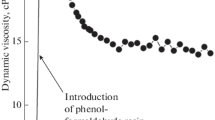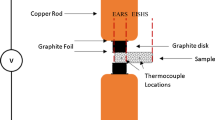Abstract
The influence of mechanical-activation (MA) conditions on the microstructure and phase composition of Ta–Hf–C reaction mixtures and products fabricated from them by self-propagating high-temperature synthesis (SHS) is investigated. The Ta–Hf–C reaction mixtures are mechanically activated in centrifugal planetary mills with various drum revolution rates. It is revealed that an increase in the drum revolution rate from 250 to 900 rpm lowers the heterogeneity scale of the reaction charge, decreases the size of coherent scattering regions of tantalum and hafnium by an order of magnitude, and leads to a rise in the degree of microdeformation of their crystal lattices by a factor of 1.5–2.0. It is established experimentally that it seems impossible to initiate an SHS reaction in the Ta–Hf–C activated mixture at initial temperature T0 < 550 K. The combustion process is implemented only at T0 = 800 K, when the adiabatic combustion temperature reaches 3274 K in mixtures treated with a revolution rate higher than 678 rpm. Single-phase carbide (Ta,Hf)C with lattice parameter a = 0.4487 nm, which corresponds to 18.0 at % dissolved HfC in TaC, is formed from reaction mixtures activated according to optimal regimes. The hafnium oxide content in products does not exceed 1%. The sample structure has high porosity (larger than 30%) and small carbide grain size (smaller than 10 μm), which makes it possible to produce the (Ta,Hf)C powder by milling the SHS product in a ball rotary mill.




Similar content being viewed by others
REFERENCES
Gaballa, O., Cook, B., and Russell, A.M., Reduced-temperature processing and consolidation of ultra-refractory Ta4HfC5, Int. J. Refract. Met. Hard Mater., 2013, vol. 41, pp. 293–299.
Simonenko, E.P., Ignatov, N.A., Simonenko, N.P., Ezhov, Yu.S., Sevastyanov, V.G., and Kuznetsov, N.T., Synthesis of highly dispersed super-refractory tantalum–zirconium carbide Ta4ZrC5 and tantalum–hafnium carbide Ta4HfC5 via sol-gel technology, Russ. J. Inorg. Chem., 2011, vol. 56, no. 11, pp. 1681–1687.
Ghaffari, S.A., Faghihi-Sani, M.A., Golestani-Fard, F., and Mandal, H., Spark plasma sintering of TaC–HfC UHTC via disilicides sintering aids, J. Eur. Ceram. Soc., 2013, vol. 33, no. 8, pp. 1479–1484.
Pierson, H.O., Handbook of Refractory Carbides and Nitrides Properties, Characteristics. Processing and Applications. Handbook, Westwood, NJ: Noyes, 1996.
Sciti, D., Silvestroni, L., Guicciardi, S., Fabbriche, D.D., and Bellosi, A., Processing, mechanical properties and oxidation behavior of TaC and HfC composites containing 15% TaSi2 or MoSi2, J. Mater. Res., 2009, vol. 24, no. 6, pp. 2056–2065.
Silvestroni, L., Sciti, D., Kling, J., Lauterbach, S., and Kleebe, H.-J., Sintering mechanisms of zirconium and hafnium carbides doped with MoSi2, J. Amer. Ceram. Soc., 2009, vol. 92, no. 7, pp. 1574–1579.
Osama Gaballa, Processing development of 4TaC–HfC and related carbides and borides for extreme environment, Graduate Theses and Dissertation 12635, 2012.
Ghaffari, S.A., Faghihisani, M.A., Golestanifard, F., and Nojabayy, M., Diffusion and solid solution formation between the binary carbides of TaC, HfC and ZrC, Int. J. Refract. Met. Hard Mater., 2013, vol. 41, pp. 180–184.
Sevast’yanov, V.G., Simonenko, E.P., Simonenko, N.P., Ezhov, Yu.S., Ignatov, N.A., and Kuznetsov, N.T., Low-temperature synthesis of tantalum carbide through a transparent tantalum–carbon containing gel, Inorg. Mater., 2010, vol. 46, no. 5, pp. 495–500.
Abdelkader, A.M. and Fray, D.J., Electrochemical synthesis of hafnium carbide powder in molten chloride bath and its densification, J. Eur. Ceram. Soc., 2012, vol. 32, no. 16, pp. 4481–4487.
Merzhanov, A.G., Kontseptsiya razvitiya samorasprostranyayushchegosya vysokotemperaturnogo sinteza kak oblasti nauchno-tekhnicheskogo protsessa (The SHS Concept as a Field of Scientific and Technical Process), Chernogolovka: Territoriya, 2003.
Varma, A. and Lebrat, J.-P., Combustion synthesis of advanced materials, Chem. Eng. Sci., 1992, vol. 47, pp. 2179–2194.
Lackner, M., Combustion Synthesis—Novel Routes to Novel Materials, Nanchang, 2010.
Aruna, S.T. and Mukasyan, A.S., Combustion synthesis and nanomaterials, Curr. Opin. Solid State Mater. Sci., 2008, vol. 12, nos. 3–4, pp. 44–50.
Liu, G., Li, J., and Chen, K., Combustion synthesis of refractory and hard materials: A review, Int. J. Refract. Met. Hard Mater., 2013, vol. 39, pp. 90–102.
Rogachev, A.S. and Mukasyan, A.S., Combustion for Material Synthesis, Boca Raton–London–New York, CRC, 2014.
Merzhanov, A.G., Solid flames: Discoveries, concepts, and horizons of cognition, Combust. Sci. Technol., 1994, vol. 98, nos. 4–6, pp. 307–336.
Munir, Z. and Anselmi-Tamburini, U., Self-propagating exothermic reactions: The synthesis of high-temperature materials by combustion, Mater. Sci. Rep., 1989, vol. 3, no. 6, pp. 279–365.
Merzhanov, A.G. and Borovinskaya, I.P., Self-propagating high-temperature synthesis of refractory inorganic compounds, Dokl. Akad. Nauk SSSR, 1972, vol. 204, no. 2, pp. 336–339.
Patsera, E.I., Levashov, E.A., Kurbatkina, V.V., and Kovalev, D.Yu., Production of ultra-high temperature carbide (Ta,Zr)C by self-propagating high-temperature synthesis of mechanically activated mixtures, Ceram. Int., 2015, vol. 41, no. 7, pp. 8885–8893.
Kurbatkina, V.V., Patsera, E.I., Vorotilo, S.A., Levashov, E.A., and Timofeev, A.N., Conditions for fabricating single-phase (Ta,Zr)C carbide by SHS from mechanically activated reaction mixtures, Ceram. Int., 2016, vol. 42, no. 15, pp. 16491–16498.
Shcherbakov, V.A. and Pityulin, A.N., Features of combustion of the Ti–C–B system, Fiz. Goren. Vzryva, 1983, vol. 19, no. 5, pp. 108–111.
Gorelik, C.C., Skakov, Yu.A., and Rastorguev, L.N., Rentgenograficheskii i elektronno-opticheskii analiz (X‑Ray and Electron-Optical Analysis), Moscow: MISiS, 1994.
ACKNOWLEDGMENTS
This work was carried out with partial financial support from the Russian Science Foundation (project no. 17-79-10173).
Author information
Authors and Affiliations
Corresponding authors
Additional information
Translated by N. Korovin
About this article
Cite this article
Patsera, E.I., Kurbatkina, V.V., Levashov, E.A. et al. Research into the Possibility of Producing Single-Phase Tantalum–Hafnium Carbide by SHS. Russ. J. Non-ferrous Metals 59, 576–582 (2018). https://doi.org/10.3103/S1067821218050127
Received:
Accepted:
Published:
Issue Date:
DOI: https://doi.org/10.3103/S1067821218050127




